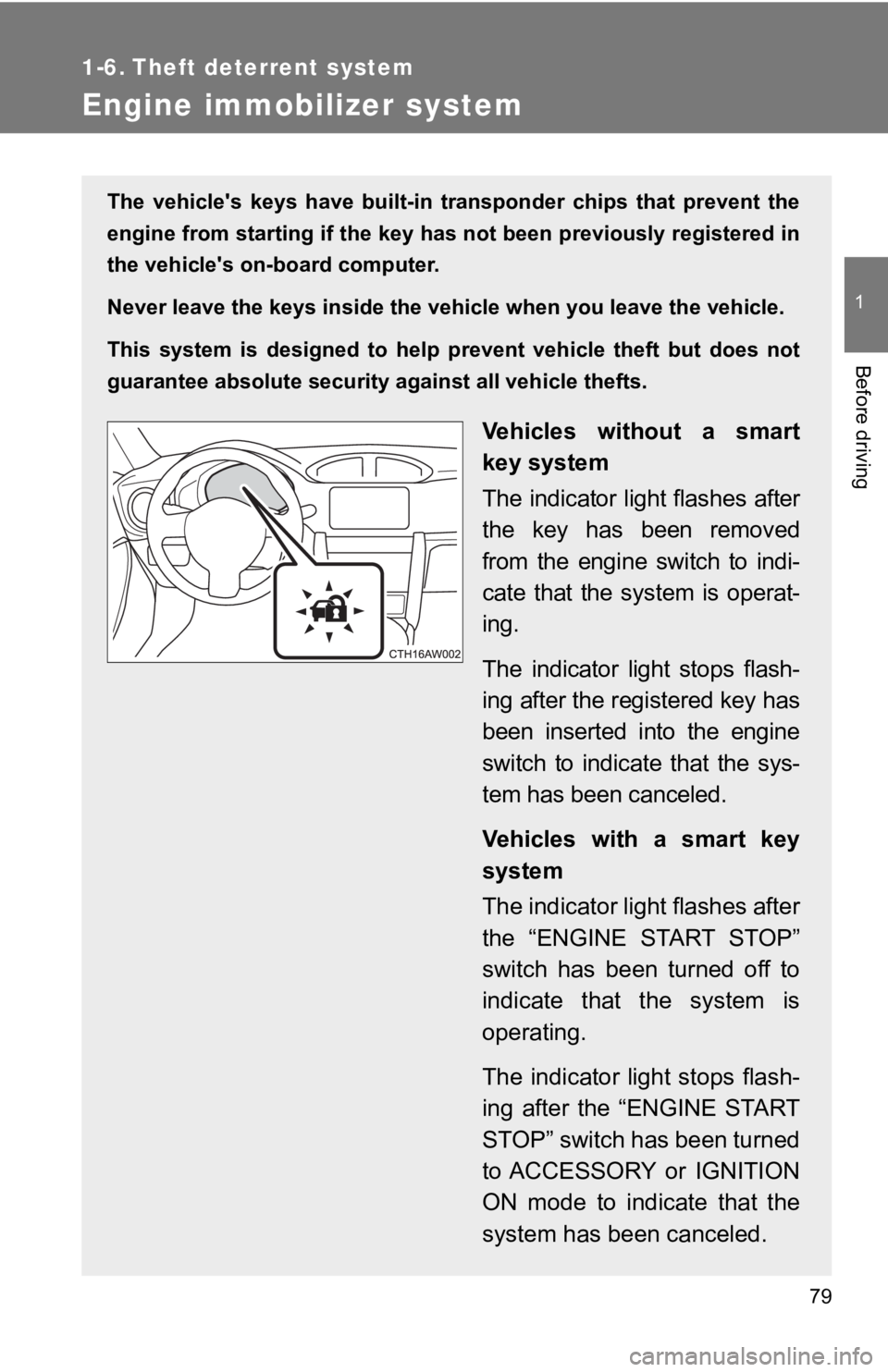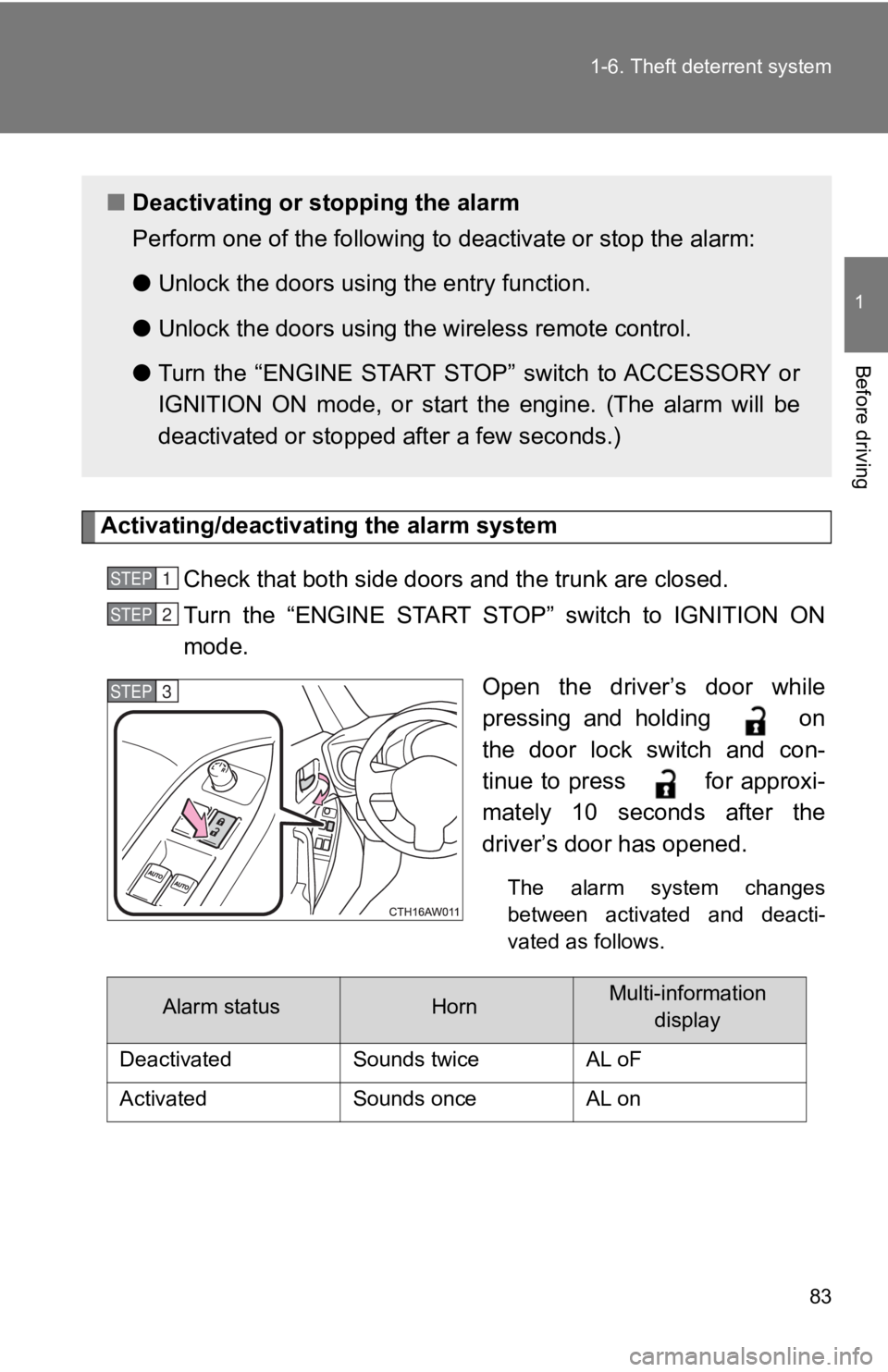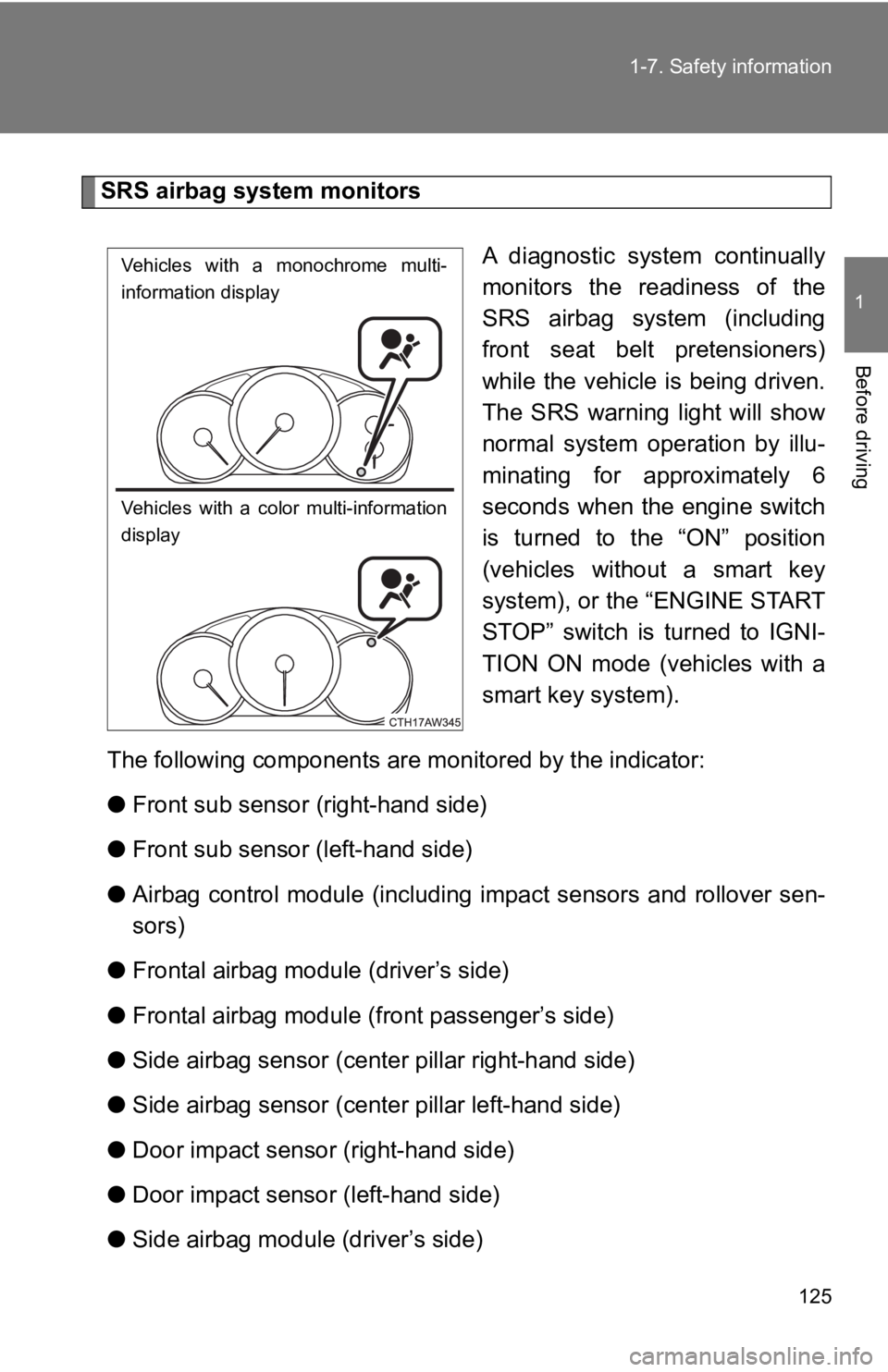engine TOYOTA 86 2019 Owner's Manual
[x] Cancel search | Manufacturer: TOYOTA, Model Year: 2019, Model line: 86, Model: TOYOTA 86 2019Pages: 532, PDF Size: 6.89 MB
Page 79 of 532

79 1
Before driving 1-6. Theft deterrent system
Engine immobilizer system The vehicle's keys have built-in tr ansponder chips that prevent the
engine from starting if the key has not been previously registe red in
the vehicle's on-board computer.
Never leave the keys inside the vehicle when you leave the vehi cle.
This system is designed to help prevent vehicle theft but does not
guarantee absolute security against all vehicle thefts.
Vehicles without a smart
key system
The indicator light flashes after
the key has been removed
from the engine switch to indi-
cate that the system is operat-
ing.
The indicator light stops flash-
ing after the registered key has
been inserted into the engine
switch to indicate that the sys-
tem has been canceled.
Vehicles with a smart key
system
The indicator light flashes after
the “ENGINE START STOP”
switch has been turned off to
indicate that the system is
operating.
The indicator light stops flash-
ing after the “ENGINE START
STOP” switch has been turned
to ACCESSORY or IGNITION
ON mode to indicate that the
system has been canceled.
Page 80 of 532

801-6. Theft det errent system
■ When the vehicle cannot be star ted with the registered key (veh icles
without a smart key system)
Remove the key and try again.
■ System maintenance
The vehicle has a maintenance-free type engine immobilizer syst em.
■ Conditions that may cause the system to malfunction
● If the key is in contact with a metallic object
● If the key is in close proximity to or touching a key to the security system
(key with a built-in transponder chip) of another vehicle
■ Certification for engine immob ilizer system (vehicles without a smart
key system)
For vehicles sold in the U.S.A.
FCC ID: MOZRI-38BFH
This device complies with part 15 of the FCC Rules. Operation i s subject to
the following two conditions: (1) This device may not cause har mful interfer-
ence, and (2) this device must accept any interference received, including
interference that may cause undesired operation.
FCC WARNING
Changes or modifications not expressly approved by the party re sponsible
for compliance could void the user’s authority to operate the e quipment.
For vehicles sold in Canada
NOTE:
This device complies with Industry Canada’s licence-exempt RSSs . Opera-
tion is subject to the following two conditions: (1) This devic e may not cause
interference; and (2) This device must accept any interference, including
interference that may cause undesired operation of the device.
NOTE:
Le présent appareil est conforme aux CNR d’Industrie Canada app licables
aux appareils radio exempts de licence. L’exploitation est auto risée aux
deux conditions suivantes: (1) l’appareil ne doit pas produire de brouillage;
(2) l’utilisateur de l’appareil doit accepter tout brouillage r adioélectrique subi,
même si le brouillage est susceptible d’en compromettre le fonc tionnement.
Page 81 of 532

811-6. Theft deterrent system
1
Before driving ■ Certification for engine immobilizer system (vehicles with a sm art key
system)
For vehicles sold in the U.S.A.
FCC ID: Y8PSSPIMB03
This device complies with part 15 of the FCC Rules. Operation i s subject to
the following two conditions: (1) This device may not cause har mful interfer-
ence, and (2) this device must accept any interference received, including
interference that may cause undesired operation.
FCC WARNING
Changes or modifications not expressly approved by the party re sponsible
for compliance could void the user’s authority to operate the e quipment.
For vehicles sold in Canada
NOTE:
This device complies with Industry Canada’s licence-exempt RSSs . Opera-
tion is subject to the following two conditions: (1) This devic e may not cause
interference; and (2) This device must accept any interference, including
interference that may cause undesired operation of the device.
NOTE:
Le présent appareil est conforme aux CNR d’Industrie Canada app licables
aux appareils radio exempts de licence. L’exploitation est auto risée aux
deux conditions suivantes: (1) l’appareil ne doit pas produire de brouillage;
(2) l’utilisateur de l’appareil doit accepter tout brouillage r adioélectrique subi,
même si le brouillage est susceptible d’en compromettre le fonc tionnement.
NOTICE
■ To ensure the system operates correctly
Do not modify or remove the system. If modified or removed, the proper
operation of the system cannot be guaranteed.
Page 83 of 532

831-6. Theft deterrent system
1
Before driving
Activating/deactivating the alarm system
Check that both side doors and the trunk are closed.
Turn the “ENGINE START STOP” switch to IGNITION ON
mode.
Open the driver’s door while
pressing and holding on
the door lock switch and con-
tinue to press for approxi-
mately 10 seconds after the
driver’s door has opened. The alarm system changes
between activated and deacti-
vated as follows.■ Deactivating or s topping the alarm
Perform one of the following to deactivate or stop the alarm:
● Unlock the doors using the entry function.
● Unlock the doors using the wireless remote control.
● Turn the “ENGINE START STOP” switch to ACCESSORY or
IGNITION ON mode, or start t he engine. (The alarm will be
deactivated or stopped after a few seconds.) STEP 1
STEP 2
STEP 3
Alarm status Horn Multi-information
display
Deactivated Sounds twice AL oF
Activated Sounds once AL on
Page 100 of 532

1001-7. Safety information
■ If the front passenger’s frontal a irbag ON indicator illuminate s and the
OFF indicator turns off even when an infant or a small child is in a child
restraint system (incl uding booster seat)
Turn the engine switch to the “LOCK” position (vehicles without a smart key
system), or turn the “ENGINE START STOP” switch off (vehicles w ith a
smart key system) if the front passenger’s frontal airbag ON in dicator illumi-
nates and the OFF indicator turns off even when an infant or a small child is
in a child restraint system (including booster seat). Remove th e child
restraint system from the seat. By referring to the child restraint manufac-
turer’s recommendations as well as the child restraint system installation
procedures in “Child restraint systems” ( P. 137), correctly install the child
restraint system. Turn the engine switch to the “ON” position ( vehicles with-
out a smart key system), or turn the “ENGINE START STOP” switch to IGNI-
TION ON mode (vehicles with a smart key system) and make sure t hat the
front passenger’s frontal airbag ON indicator turns off and the OFF indicator
illuminates.
If still the ON indicator remains illuminated while the OFF ind icator turns off,
take the following actions.
● Ensure that no article is placed on the seat other than the chi ld restraint
system and the child occupant.
● Ensure that the backward-forward position and seatback of front passen-
ger’s seat are locked into place securely by moving the seat back and
forth.
If the ON indicator still remains illuminated while the OFF indicator turns off
after taking relevant corrective actions described above, reloc ate the child
restraint system to the rear seat and immediately contact your Toyota dealer
for an inspection.
NOTE
When a child who has outgrown a child restraint system or a sma ll adult is
seated in the front passenger’s seat, the Toyota advanced front al airbag sys-
tem may or may not activate the front passenger’s SRS frontal a irbag
depending on the occupant’s seating posture. The child should a lways wear
the seat belt when sitting in the seat irrespective of whether the airbag is
deactivated or activated. If the front passenger’s SRS frontal airbag is acti-
vated (the ON indicator remains illuminated while the OFF indic ator turns
off), take the following actions.
Page 102 of 532

1021-7. Safety information
■ If the passenger’s frontal airbag OFF indicator illuminates and the ON
indicator turns off even when the front passenger’s seat is occ upied by
an adult
This can be caused by the adult incorrectly sitting in the fron t passenger’s
seat. Turn the engine switch to the “LOCK” position (vehicles w ithout a smart
key system), or turn the “ENGINE START STOP” switch off (vehicl es with a
smart key system). Ask the front passenger to set the seatback to the
upright position, sit up straight in the center of the seat cus hion, correctly
fasten the seat belt, position his/her legs out forward, and ad just the seat to
the rearmost position. Turn the engine switch to the “ON” posit ion (vehicles
without a smart key system), or turn the “ENGINE START STOP” sw itch to
IGNITION ON mode (vehicles with a smart key system). If the OFF indicator
remains illuminated while the ON indicator remains off, take th e following
actions.
● Vehicles without a smart key system:
Turn the engine switch to the “LOCK” position.
Vehicles with a smart key system:
Turn the “ENGINE START STOP” switch off.
● Make sure that the front passenger does not use a blanket, seat cushion,
seat cover, seat heater or massager, etc.
● If wearing excessive layers of clothing, the front passenger should
remove any unnecessary items before sitting in the front passenger’s
seat, or should sit in a rear seat.
● Next, turn the engine switch to the “ON” position and wait 6 se conds to
allow the system to complete self-checking. Following the syste m check,
both indicators turn off for 2 seconds. Now, the ON indicator should illu-
minate while the OFF indicator remains off.
If the OFF indicator still remains illuminated while the ON ind icator remains
off, ask the occupant to move to the rear seat and immediately contact your
Toyota dealer for an inspection.
Page 104 of 532

1041-7. Safety information
The SRS airbag can function only when the engine switch is in t he “ON”
position (vehicles without a smart key system) or when the “ENG INE START
STOP” switch is in IGNITION ON mode (vehicles with a smart key system).
The Toyota advanced frontal airbag system is designed to determ ine the
activation or deactivation condition of the front passenger’s S RS frontal air-
bag depending on the characteristic of the item(s) or person on the front
passenger’s seat monitored by the front passenger’s occupant cl assification
system sensor. For this reason, only the driver’s SRS frontal a irbag may
deploy in the event of a collision, but this does not mean fail ure of the sys-
tem.
If the front sub sensors and the impact sensors in the airbag c ontrol module
detect a predetermined amount of force during a frontal collisi on, the control
module sends signals to the airbag module(s) (only driver’s mod ule or both
driver’s and front passenger’s modules) instructing the module( s) to inflate
the SRS frontal airbag(s).
The driver’s and front passenger’s SRS frontal airbags use dual stage infla-
tors. The two inflators of each airbag are triggered either seq uentially or
simultaneously, depending on the severity of impact, in the cas e of the
driver’s SRS frontal airbag and depending on the severity of im pact and the
characteristic of the item(s) or person on the seat in the case of the front
passenger’s SRS frontal airbag.
After deployment, the SRS airbag immediately starts to deflate so that the
driver’s vision is not obstructed. The time required from detec ting impact to
the deflation of the SRS airbag after deployment is shorter tha n the blink of
an eye.
Both when only the driver’s SRS frontal airbag deploys and the driver’s and
front passenger’s SRS frontal airbags deploy, the driver’s and front passen-
ger’s seat belt pretensioners operate at the same time.
Although it is highly unlikely that the SRS airbag would activa te in a non-
accident situation, should it occur, the SRS airbag will deflat e quickly, not
obscuring vision and will not interfere with the driver's abili ty to maintain con-
trol of the vehicle.
When the SRS airbag deploys, a sudden, fairly loud inflation no ise will be
heard and some smoke will be released. These occurrences are a normal
result of the deployment. This smoke does not indicate a fire i n the vehicle.
Page 111 of 532

1111-7. Safety information
1
Before driving ■ Operation
The SRS side airbag and SRS curtain shield airbag can function only when
the engine switch is in the “ON” position (vehicles without a s mart key sys-
tem) or when the “ENGINE START ST OP” switch is in IGNITION ON m ode
(vehicles with a smart key system).
The driver’s and front passenger’s SRS side airbags and SRS cur tain shield
airbags deploy independently of each other since each has its o wn impact
sensor. Therefore, they may not both deploy in the same acciden t. Also, the
SRS side airbag and SRS curtain shield airbag deploys independe ntly of the
driver’s and front passenger’s SRS front airbags in the steerin g wheel and
instrument panel.
A rollover sensor is also located inside the airbag control mod ule.
An impact sensor, which senses impact force, is located in each of the left
and right center pillars, doors and rear wheel houses. Another impact sen-
sor, which also senses impact force, is located under the cente r of the rear
seats.
If the impact sensor that is located under the center of the re ar seats and
one of the center pillar impact sensors or door impact sensors together
sense an impact force above a predetermined level in a side col lision, the
control module causes both the SRS side airbag and curtain shield airbag on
the impacted side to inflate regardless of whether the rear whe el house
impact sensor on the same side senses an impact.
If the impact sensor that is located under the center of the re ar seats and
one of the rear wheel house impact sensors together sense an im pact force
above a predetermined level, the control module causes only the SRS cur-
tain shield airbag on the impacted side to inflate.
If the rollover sensor detects rollover of the vehicle, the control module
inflates the SRS curtain shield airbags. At this time, the driver's and front
passenger’s seat belt pretensioners also operate at the same ti me.
Page 125 of 532

1251-7. Safety information
1
Before driving SRS airbag system monitors
A diagnostic system continually
monitors the readiness of the
SRS airbag system (including
front seat belt pretensioners)
while the vehicle is being driven.
The SRS warning light will show
normal system operation by illu-
minating for approximately 6
seconds when the engine switch
is turned to the “ON” position
(vehicles without a smart key
system), or the “ENGINE START
STOP” switch is turned to IGNI-
TION ON mode (vehicles with a
smart key system).
The following components are mo nitored by the indicator:
● Front sub sensor (right-hand side)
● Front sub sensor (left-hand side)
● Airbag control module (including impact sensors and rollover se n-
sors)
● Frontal airbag modu le (driver’s side)
● Frontal airbag module ( front passenger’s side)
● Side airbag sensor (center pillar right-hand side)
● Side airbag sensor (center pillar left-hand side)
● Door impact sensor (right-hand side)
● Door impact sensor (left-hand side)
● Side airbag module (driver’s side) Vehicles with a monochrome multi-
information display
Vehicles with a color multi-information
display
Page 127 of 532

1271-7. Safety information
1
Before driving WARNING■ SRS warning light
If the warning light exhibits any of the following conditions, there may be a
malfunction in the seat belt pretensioners, SRS airbag system a nd/or front
passenger occupant classification system. Immediately take your vehicle to
your nearest Toyota dealer to have the system checked. Unless c hecked
and properly repaired, the seat belt pretensioners, SRS airbag and/or front
passenger occupant classification system will not operate prope rly in the
event of a collision, which may increase the risk of death or s erious injury.
● Flashing or flickering of the warning light
● No illumination of the warning light when the engine switch is first turned to
the “ON” position (vehicles without a smart key system), or the “ENGINE
START STOP” switch is turned to IGNITION ON mode (vehicles with a
smart key system).
● Continuous illumination of the warning light
● Illumination of the warning light while driving